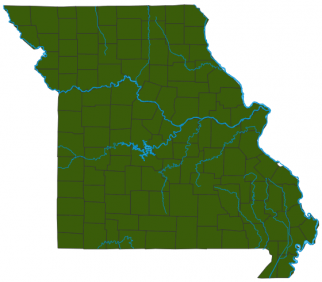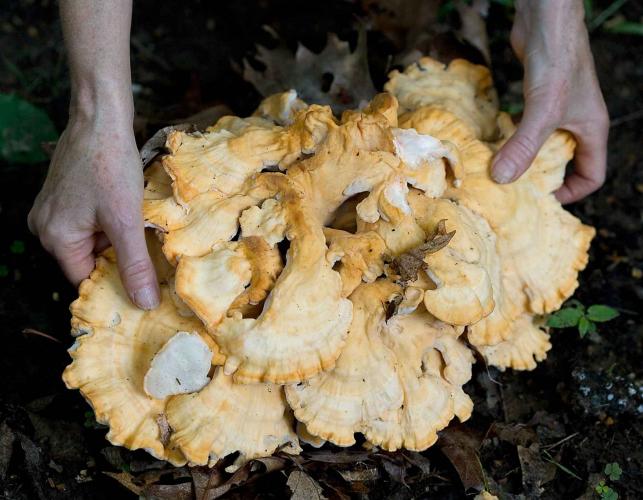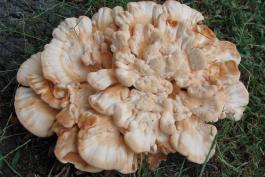
Layered, rosette or fan-shaped, fleshy; orange to pinkish orange on top; white below. Grows in overlapping clusters or rosettes on dead or dying deciduous trees, often at the base of trees, or on stumps, buried roots, or living trees. May–November. Each cap flat, fan-shaped or semicircular; light orange to pinkish orange when fresh, turning pale orange with age; texture fleshy. Pores angular; white or off-white. Stalk not present. Spore print white. Spores magnified are elliptical to round.
Lookalikes: Sulfur-colored chicken of the woods (Laetiporus sulphureus) has a bright sulfur yellow (not white) underside. No other Missouri mushrooms have the color, shape, and growing habit of the two “chicks” (L. cincinnatus and L. sulphureus).
Cap width: 2–12 inches (each cap).

Statewide.
Habitat and Conservation
Grows in overlapping clusters or rosettes on stumps, trunks, and logs of dead or dying deciduous trees, often at the bases of trees, especially oaks. It can also grow on living trees and buried roots. Chicken of the woods clusters can grow very large, with up to 50 overlapping caps in a cluster.
Status
Considered a choice edible. Some people think this species is more tender than the sulfur-colored chicken of the woods (Laetiporus sulphureus). They both have the texture of chicken, and with a little imagination can taste like chicken. Although both species are safe and delicious mushrooms, some people get a bit of stomach upset or swollen lips after eating them. Try just a small amount the first time.
Life Cycle
This species lives as a network of cells (mycelium) within living trees as a parasite, and dead trees as a saprobe, that digests and decomposes the wood. When ready to reproduce, the mycelium develops the brackets that emerge from the log, which are reproductive structures. Spores are produced in the pores on the underside and are released to begin new mycelia elsewhere.
Human Connections
This fungus can be used as a chicken substitute in casseroles, enchiladas, and more. As with all wild mushrooms, be absolutely sure of your identification, cook it well, and only eat a small amount the first time you try it, since some people have bad reactions to otherwise edible mushrooms.
Ecosystem Connections
This is one of the many fungus species that live on decaying wood. It and other such saprobic fungi play an incredibly important role in breaking down the tough materials wood is made of and returning those nutrients to the soil.




Mushrooms are a lot like plants, but they lack chlorophyll and have to take nutrients from other materials. Mushrooms are neither plants nor animals. They are in a different kingdom — the fungi. Fungi include the familiar mushroom-forming species, plus the yeasts, molds, smuts, and rusts.
Always be cautious when eating edible mushrooms. Be absolutely sure of the ID, and only eat a small amount the first time you try it to avoid a reaction..





















